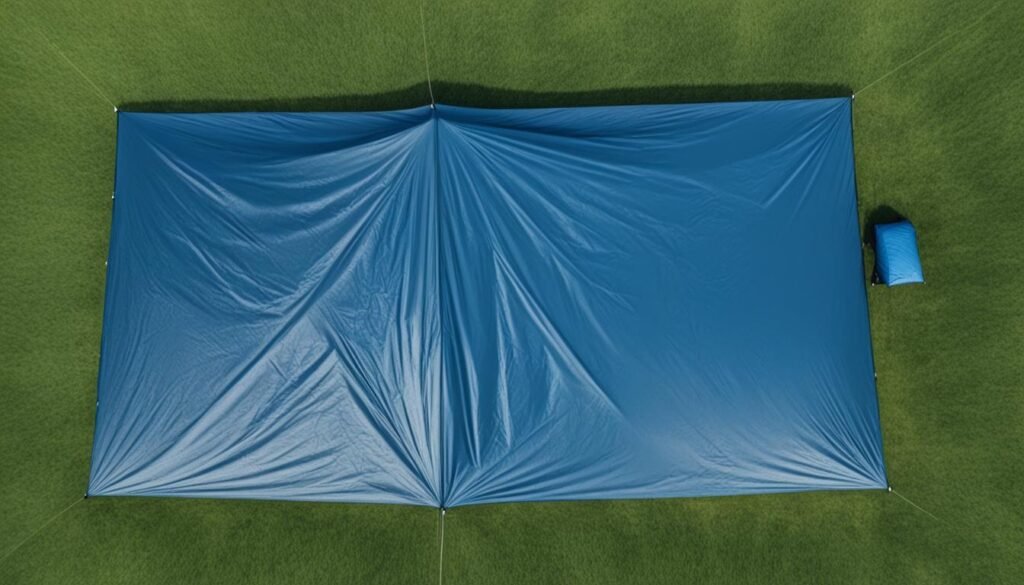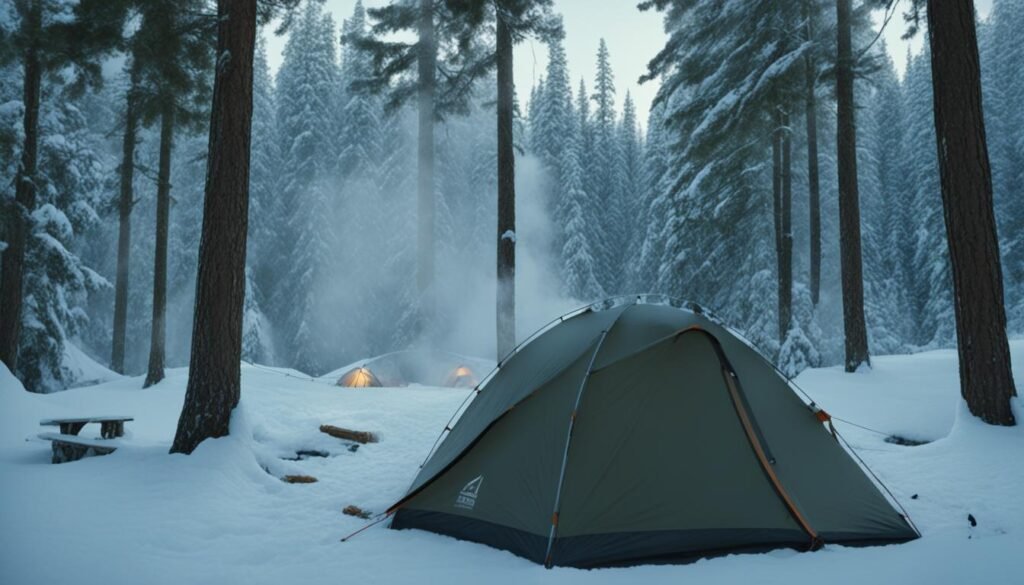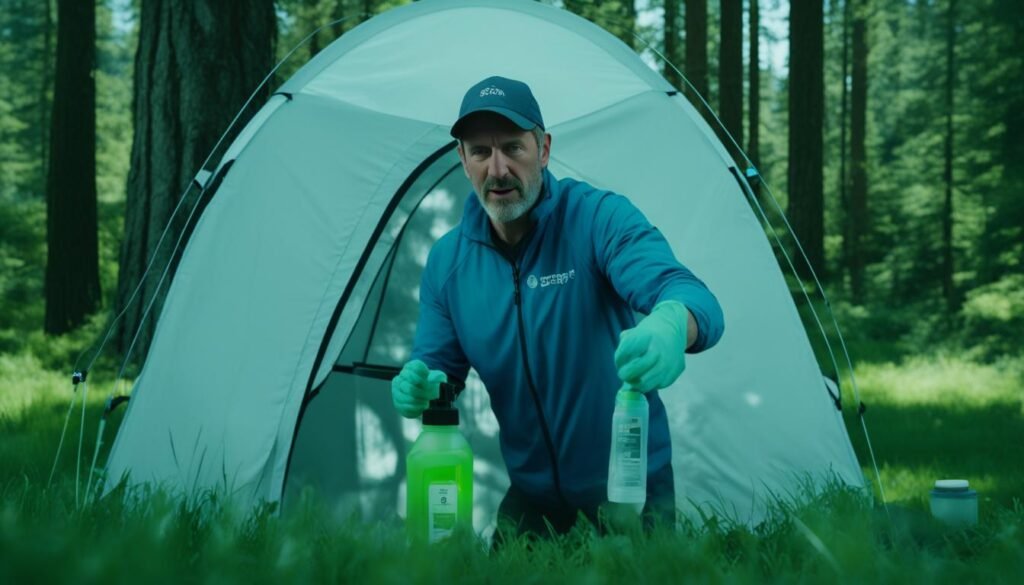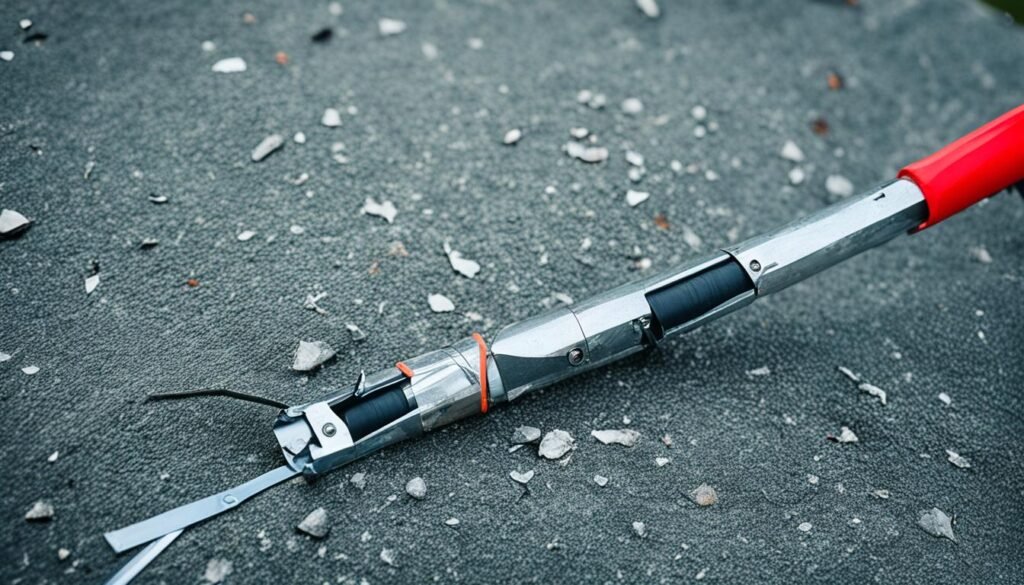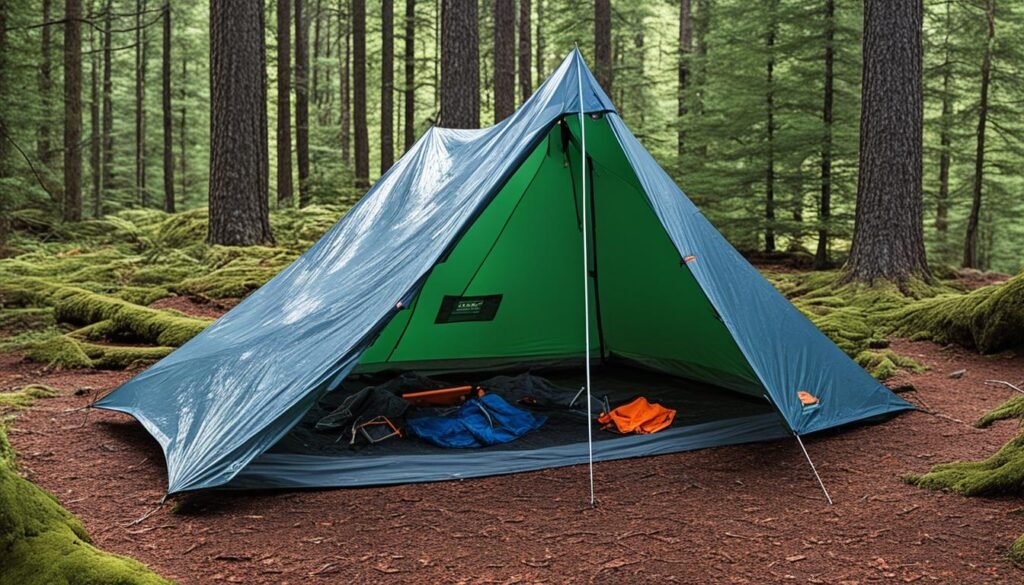Finding the right campsite is key for a fun outdoor trip. Think about flat areas, being close to water, and if there’s firewood. A good spot will help you sleep well and have a place to cook, clean, and drink.
Don’t choose valleys or places near animals or dangers. Keep at least 200 feet from still water to avoid bugs. Find a spot with a soft, natural layer like pine needles for warmth and comfort.
Choose a location that’s shielded from the wind and flood-free. Always test the ground by lying down before you pitch your tent. These tips are from National Geographic’s “The Ultimate Hiker’s Gear Guide.”
Finding a Safe and Reliable Campsite
Choosing a level ground for your camp is very important. A flat area helps you stay comfy and your tent stable. Start looking for a good spot by mid-day to find it and set up before dark. This helps you sleep better at night.
Look for dry ground too. It makes your sleep warmer and cosier. Find a place without rocks for a safer experience.
To avoid wildlife, don’t camp near their trails or homes. This keeps you safe and undisturbed at night. Also, stay away from areas with natural dangers like floods or avalanches. These places can make camping risky.
Use natural materials like pine needles for the ground. This makes it nicer to walk on and helps your tent stay secure.
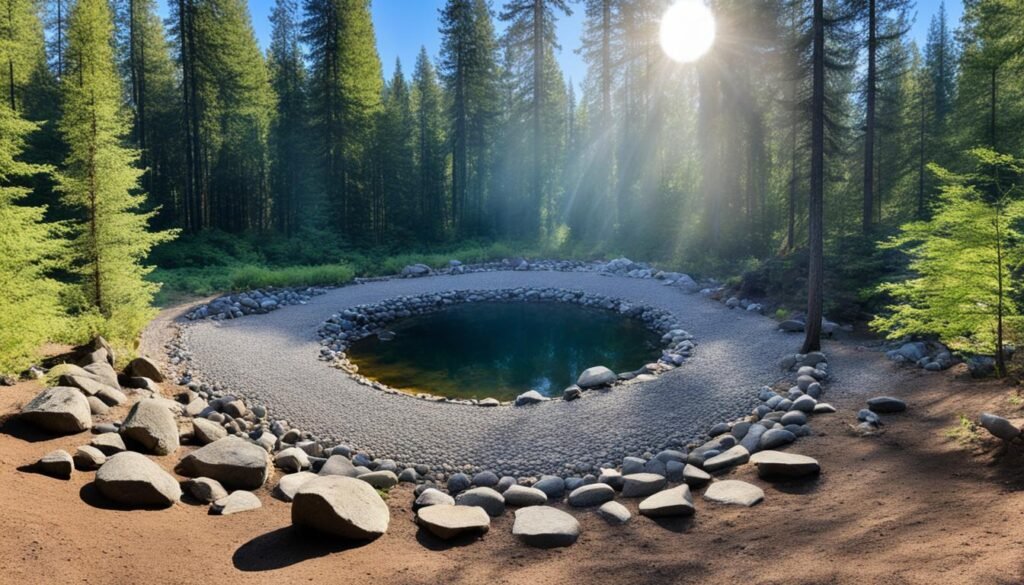
Lastly, make sure the campsite drains well. Avoid spots that flood, especially if it might rain. A dry spot makes your camping trip safer and more fun. Consider all these tips for a great and safe adventure.
- Begin searching halfway through the day for optimal spot selection.
- Seek level, dry ground for stability and warmth.
- Avoid animal trails and prime habitats to prevent wildlife encounters.
- Stay away from natural hazard zones like avalanches and flash floods.
- Utilize natural ground cover for added comfort.
- Confirm proper drainage to avoid flooding risks.
Evaluating Campsite Comfort
Choosing the right campsite is the first step to a comfy night. Make sure the ground is flat and dry. This helps your tent stay stable and you sleep better. Around 80% of campers like it when the ground is level.
Adding natural things under your sleeping bag helps. Leaves or moss can make it more comfy and warm.
Watch out for things that could fall on you, like dead branches. Also, place your tent behind big rocks or trees. They act as a shield against strong winds. This makes camping more comfy.
Pick a spot that’s not too low, to avoid water piling up. Many campers stay away from low areas for this reason. Also, high spots keep you away from cold, damp air.
Privacy matters a lot to most people while camping. Being surrounded by nature or having space from others helps. But, it’s not just about where you camp.
Choose a spot that matches how you like to sleep. For example, if you like an elevated head, try to find a spot like that. It really helps with how comfy you feel.
Being close to water and bathrooms makes things much easier. If a site is less than 0.25 miles (400m) from water, that’s great. It makes cooking, washing, and following camping rules a lot simpler. Think about these things when you pick a spot for a cozy camp.
Choosing Locations with Appropriate Water Drainage
Choosing a campsite with good water drainage stops your tent from flooding. Look for higher ground when you set up. High areas see 40% less flooding than low spots.
Keep your camp at least 200 feet from water. This rule helps stay safe from rising water. It also keeps your site clean and follows local laws.
Don’t camp where water might flow towards your tent. In places like deserts, stay high to avoid sudden water. This step is very important.
Digging a small trench around your tent can protect it from water. But always fix the ground after, to care for nature.
Choosing a flat spot is also good. Most campers say it helps them rest better. Plus, it stops water from gathering near your tent.
Think about trees and the weather too. Don’t camp under the tallest trees to stay safe from lightning. Find a spot shielded from strong winds to cut down on weather troubles.
By picking the right site and avoiding water trouble, your camping trip will be safer and more enjoyable.
Avoiding Noisy and Busy Areas
For a peaceful camping time, pick quiet spots away from crowds. Places with a lot of people can take away your peace. Loud noises from others moving around and opening doors can disturb you. This makes it hard to fully enjoy the calm of the great outdoors.
- Look for campsites that are not close to popular paths or crowded areas.
- Place your tent so its entrance isn’t facing places people often walk, reducing disturbances.
- Use natural things like trees or bushes to block sounds, making your space quieter.
If you like camping in popular places, book early. This way, you can find a peaceful spot. Sites close to water are great because you can use it for cooking and cleaning. Also, the sound of water can be very calming. For those who really want quiet, look into backcountry camping. This is in places like national parks, forests, and state parks. Here, you camp away from others, deep in nature. Remember, you might need a special permit for these areas. Always check the rules before you go. Choosing a quiet campsite away from noise is key to a relaxing trip. It’s also important to be a good camper. This means being quiet for others and keeping the peace.
Selecting a Campsite with Proper Sun and Shade Balance
Finding the right balance of sun and shade is key for a perfect camping spot. It should keep you comfortable by mixing sunlight and shade well.
In *Santa Fe, New Mexico*, April weather can vary a lot. Highs reach 65°F (18°C) and lows drop to 32°F (0°C). This shows why picking a campsite with the correct mix of sun and shade is crucial. Morning sun warms you up, and shade cools you down in the hot months.
To get the balance right, watch how the sun moves and place your tent smartly. This way, you can stay comfy, getting warmth or coolness as needed. Use these steps to make the most of the sunlight:
- Use trees and rocks to create shady spots.
- Set up your tent to catch the morning sun for warmth.
- Find shade in the afternoon to stay cool.
Knowing about your camping area’s features is important for comfort. This is true whether you’re at a site with lots of features or in a hidden place in the woods. The right mixture of sun and shade can make your camping better and safer.
Checking for Potential Tree Hazards
Choosing a safe campsite is key to a great trip. Always look for signs of dangerous trees when camping. By spotting these tree hazards, you can make sure you stay safe. Here are tips for safe campsite selection to keep away from threats:
- Dead and leaning trees: These trees may be dangerous, especially if many dead ones are on the ground.
- Weather conditions: Bad weather like strong winds, lightning, and heavy rain make tree falls more likely.
- Damaged trunks: Trees hurt by cutting, animal damage, or car accidents are more likely to fall.
- Standing alone trees: If a tree is the only one left standing, it might have a hidden problem.
- Conks presence: Fungus on a tree can mean it’s rotting inside, especially at the base.
- Dead branches: Watch for dead branches in trees or caught in the branches because they can fall.
- Cracks: Cracks in a tree’s trunks or branches can turn into big problems if the tree falls.
- Sawdust piles and peeling bark: Signs like sawdust piles and bark peeling off can mean the tree is weak.
- Mushrooms at the base: Mushrooms around the tree’s bottom can show the roots are sick, and the tree may fall.
It’s important to always check for tree dangers, not just during camping. People who hammock camp should make sure the trees holding their hammocks are safe. By being careful and checking for these tree warnings, you can make your camping trip safer and more fun.
Ensuring Safety from Animal Presence
When you’re camping and want to be safe from animals, you must be very careful. It’s best to camp away from trails animals use and not close to water where they drink. There have been times when lions were seen near places where people camp, like in Mikumi National Park. This shows it’s important to know about the risks.

Following rules and getting advice from experts can keep you safe from animals at campsites. Keeping food and trash sealed tight helps prevent visits from night-loving animals like baboons and elephants. Even with fences, animals like hippos and lions can still get into camps. This happens more than you might think, so it’s good to be careful.
There are some important steps to avoid meeting wildlife up close:
- Do not leave food unattended: Be sure to keep food smells from drawing animals near your camp.
- Do not feed the wildlife: It’s better not to feed them, so they stay away and find their own food.
- Do not provoke animals: Always be careful and kind around animals to avoid danger.
- Secure your tent nightly: Use alarms if you can to stay safe, because animals might try to get in your tent.
Knowing what animals are around can help you prepare better. Most campers see deer, and many see squirrels, so it’s good to watch out. You might also meet bears, but most campers are ready for that. Encounters with coyotes don’t happen much, and though snakes and spiders scare some people, being ready and proactive can make your camping trip great.
Clearing the Site of Sharp Objects
Before setting up your tent, it’s key to clear the ground. Rocks, pinecones, and sticks are sharp things everywhere. They can harm your camping stuff and you.
Let’s look at the Kentucky Horse Park campground. Out of over 100 spots, only four have tents. This shows how important it is to be careful. Check the ground where you’ll pitch your tent. Make sure there’s nothing sharp that could tear your stuff or keep you up at night.
When getting your campsite ready, remember to:
- Walk around and pick up any sharp things you see.
- Know that some places have rules on how long you can stay or if you can stay in a tent. This is because of trees and tight paths.
- Pick a spot with trees. They protect you from the wind and give you shade.
- Don’t camp too near toilets to avoid bad smells. Or too close to roads to have lights and noise bother you.
To end, always follow the Leave No Trace rules. They help keep nature as it should be. Don’t camp in special places or go outside the camping area. Your actions affect the environment around you.
Adhering to the 200-Foot Rule
Eco-friendly camping means we need to keep our campsite 200 feet away from water sources and paths. This keeps nature safe. It also makes sure animals stay away from our things.
It’s best to pick a spot already chosen for camping. Signs by the forest service mark the right places. You’ll see a fire spot and flattened ground. Using these areas keeps the natural beauty safe.
In some very delicate spots, you must camp even farther, at a quarter mile. But in busy places like the White Mountains, camping close to a trail is okay if it’s already set up.
To be even more helpful to nature, learn and follow the rules. Stick to paths and camp in places meant for it. Remember, the best sites are the ones that are already there, not new ones.
- Camp at least 200 feet away from water sources and trails.
- Use designated campsites to minimize ecological impact.
- Look for pre-existing campsites to help concentrate the impact.
- Be aware of and follow local regulations to avoid fines.
- Embrace Leave No Trace principles to protect the environment.
By obeying these rules, we lessen the harm to nature. We keep it beautiful for everyone, and we live in harmony with our natural world.
How to Choose the Perfect Campsite for Your Tent
Choosing the best campsite involves several key factors for a safe and comfy spot. Your tent camping guide starts by choosing a site carefully. It should meet important needs.
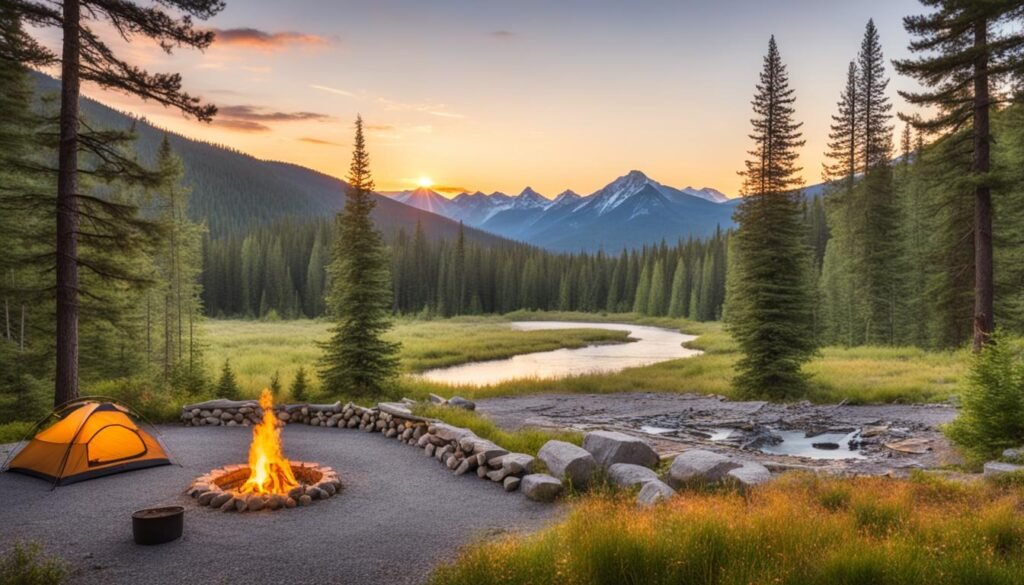
First, pick a spot 200 feet from paths and water. This keeps the area clean and stops wet tents.
Look for flat spots to sleep on, and pick grounds like dirt, rock, or sand. Avoid beds of flowers and moss as they’re easily hurt.
Stay safe in the woods. Watch for falling branches. Pick shielded spots to camp if it’s windy. Also, find places with good views and not too many people.
Tom Stienstra knows campgrounds are different for everyone. His books suggest top spots for fishing, views, and walks. This helps find your favorite spot.
Parks can make camping better, but remote areas have their charm. Tom suggests choosing pretty sites for more fun outside.
Looking at pictures online can show you great places to camp. Easy to reach spots are nice for quick getaways. This is key on busy weekends.
Plan day trips from camp. High ground is ideal in rain. Set up your tent to catch sun how you like it. Always check the ground, and pick spots without things to trip over.
Enjoy new things and pick fun stuff to do, says Tom. His book, Moon California Camping, is full of tips for great times outside.
Studies show most people at Sajama Park like the comforts of standard sites. In Altai Tavan Bogd, many choose wilder spots. At Sangre de Cristo, good water flow is crucial. In Sahara’s Erg Chebbi, views and water spots are equally loved.
Understanding Local Weather Conditions
Picking the right campsite means knowing the local weather well. It’s important to look at both the current weather and how quickly it can change. Being ready for the weather can make your camping trip safer and more fun.
- Review weather forecasts: Always check the weather forecasts before heading out. This helps in preparing for weather changes accurately.
- Select elevated spots: Elevated campsites are breezier and have fewer mosquitoes, especially near bodies of water.
- Avoid valleys: It’s best to set your campsite uphill from valley bottoms. Doing this prevents cold, dense air from sitting low and keeps you warmer overnight.
- Stay clear of water bodies: Studies show that camping at least 200 meters away from water is better. It reduces the chances of running into wild animals and follows rules for nature conservation.
- Utilize natural windbreaks: Trees can shield you from strong winds and thunderstorms. This makes your camping spot safer and more pleasant.
Considering these tips about the weather will make your camping trip better. It helps you get ready for different weather and have a safer time.
Focusing on Leave No Trace Principles
Choosing a campsite wisely is key in caring for nature. The Leave No Trace Center for Outdoor Ethics offers seven principles. These are meant to assist outdoor lovers in enjoying the wild while lessening their impact. They guide us in keeping nature safe and beautiful for tomorrow.
First up is “Plan Ahead and Prepare.” This principle asks us to learn the rules, pick low-traffic times, and pack food smartly to cut down on trash. Then, “Travel and Camp on Durable Surfaces” tells us to stick to marked paths and campsites. It shares the importance of not altering these spots, to keep our mark small.
The third principle, “Dispose of Waste Properly,” reminds us to clean up after ourselves. It tells us to carry out all trash, use the bathroom in the right places, and wash far from water sources. The other principles like “Leave What You Find” and “Minimize Campfire Impacts” stress protecting nature and other visitors by using the right camping methods.
“Respect Wildlife” is another important rule. It means keeping our distance from animals and ensuring our pets don’t bother them. By following these principles, campers play a big part in keeping nature pure. These rules apply whether we’re camping close to home or in the wild. They help us build a caring and sustainable bond with the natural world.

